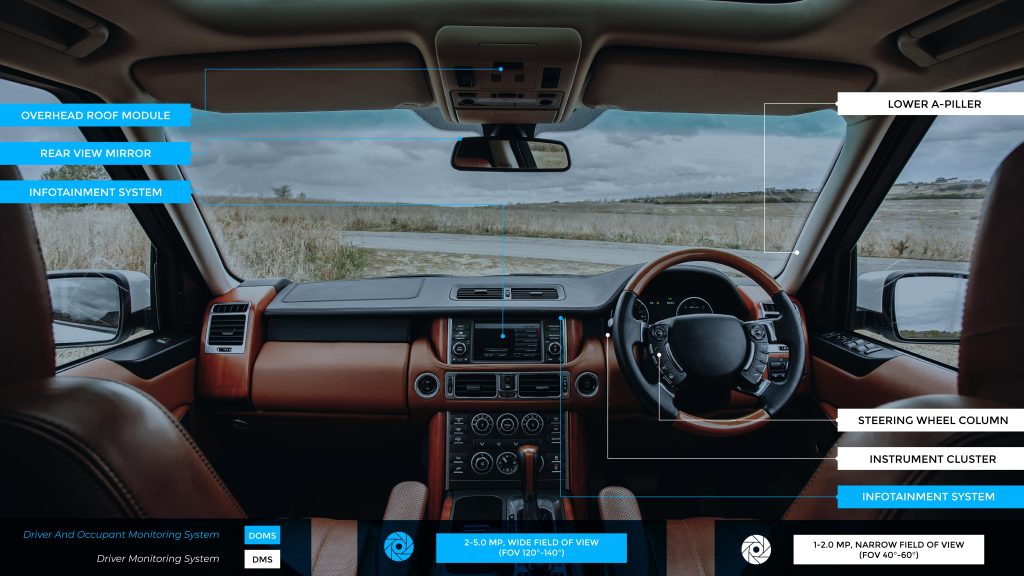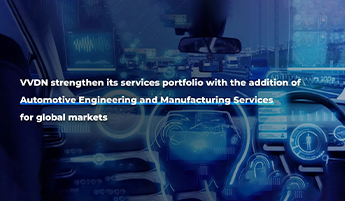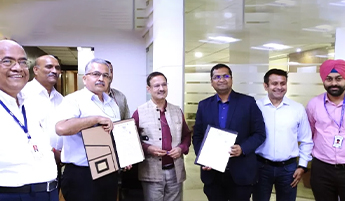With the increasing focus on reducing road accidents, regulatory mandates, and the demand for a more personalized driving experience, driver monitoring systems (DMS) and occupant monitoring systems (OMS) have emerged as critical components in modern vehicles. These systems are designed to improve driver alertness, reduce accidents caused by distraction or fatigue, and ensure occupant safety by monitoring their condition and environment.
As vehicles progress toward higher levels of automation, the role of DMS and OMS becomes even more essential in bridging the gap between manual and autonomous driving. These systems are rapidly becoming mandatory features in new vehicles, ensuring that drivers are not only assisted by technology but are also monitored for safe driving behavior.
Types of Monitoring Systems
Driver Monitoring Systems (DMS): DMS tracks the driver’s behavior and physiological state through cameras and sensors installed in the dashboard. These systems monitor eye movement, head positioning, and facial expressions to detect fatigue, distraction, or impairment. Real-time alerts prompt the driver to regain focus or rest, thereby reducing the likelihood of accidents.
Occupant Monitoring Systems (OMS): OMS systems monitor passengers in the vehicle, identifying factors such as seatbelt usage, seat position, and occupant health. Advanced OMS can even measure vital signs like heart rate, allowing for intervention in case of a medical emergency. These systems enhance safety by tailoring the vehicle’s response, such as adjusting airbag deployment or seatbelt tension based on occupant position and condition.

The Growing Importance of DMS and OMS
The need for DMS and OMS have never been more pressing. Regulatory bodies such as the European New Car Assessment Programme (Euro NCAP) have included DMS as part of their safety ratings, further pushing the industry to adopt these technologies. The rise in distracted driving due to smartphone usage and the long hours spent on the road demands solutions that actively monitor the driver’s alertness.
For occupant monitoring, the ability to detect children left unattended in cars or ensure proper seat belt usage can drastically reduce fatalities in collisions. As autonomous vehicles gradually become mainstream, the need for these systems grows, ensuring that drivers can take over control when necessary and that occupants remain safe.
Key Technologies Driving DMS and OMS
Cameras and sensors: The backbone of any driver monitoring system (DMS) or occupant monitoring system (OMS) is its array of sophisticated cameras and sensors. These devices capture high-resolution images and physiological data, analyzed in real-time. VVDN specializes in designing camera systems optimized for various conditions, supporting different camera types such as RGB and infrared (IR). Our camera modules range from 2MP to 8MP, with wide-angle lenses (up to 140° FOV) ensuring full cabin coverage. We fine-tune lens selection for low-light performance and adjust focus based on distance (e.g., telephoto lenses for precise eye tracking). Our system performs optimally across variable lighting conditions, glare, and temperature fluctuations.
AI and Machine Learning: AI is integral to DMS and OMS, with advanced deep learning algorithms processing data captured by cameras and sensors. VVDN leverages convolutional neural networks (CNNs) for real-time image processing, recognizing critical patterns indicating fatigue, distraction, or abnormal behavior. Algorithms such as YOLO (You Only Look Once) are employed for rapid object detection and tracking, while recurrent neural networks (RNNs) or long short-term memory (LSTM) networks help model driver behaviors over time, enabling prediction of future actions. These AI models are optimized for various System-on-Chips (SoCs) like Qualcomm, NXP, Ambarella, and Renesas with hardware-accelerated inference through GPU, DSP, or dedicated NPU. VVDN’s algorithmic optimization ensures low latency and power efficiency, crucial for embedded automotive applications.
Sensor Fusion: To provide a complete understanding of the vehicle’s interior, DMS and OMS rely on sensor fusion techniques. This combines data from multiple sensors—such as IR cameras, ultrasonic sensors, and millimeter-wave radar—to produce a 360-degree view of the driver and passengers. VVDN excels at implementing sensor fusion algorithms that merge disparate data streams to generate a coherent and accurate representation of occupant states. These algorithms minimize noise and errors from individual sensors, ensuring reliable performance even in challenging environments like extreme lighting conditions or rapid vehicle movements.
Challenges in Developing DMS and OMS
Accurate driver detection: A significant challenge for DMS is accurately detecting driver fatigue and distraction under various conditions. Monitoring eye movement in bright sunlight or detecting subtle signs of drowsiness requires sophisticated image processing and AI models. VVDN addresses this by leveraging expertise in sensor calibration and AI-based image processing, ensuring system accuracy across a wide range of environments.
Occupant Position and Health Monitoring: Detecting an occupant’s exact position and health status can be difficult, especially with children or unusual seating positions. Advanced seat sensors and infrared imaging are crucial in overcoming this challenge. VVDN’s experience in integrating these technologies allows us to create systems that provide accurate occupant data.
Environmental and Lighting Conditions: DMS and OMS must function reliably under changing lighting conditions, such as night driving, low light, or direct sunlight. VVDN employs robust design methodologies, including high dynamic range (HDR) imaging and IR cameras, ensuring system functionality in all conditions.
Data Processing and Integration: Real-time monitoring generates large volumes of data that must be processed quickly and efficiently. AI-driven analytics and advanced computing platforms are essential for processing this data without compromising performance. VVDN’s expertise in embedded systems and real-time data processing enables high-performance DMS and OMS solutions that meet the automotive industry’s stringent requirements.
Advancing Safety with DMS and OMS Solutions
VVDN Technologies leverages its extensive expertise in automotive electronics and software to design, develop, and manufacture advanced Driver Monitoring Systems (DMS) and Occupant Monitoring Systems (OMS) for OEMs and Tier-1 suppliers. Our capabilities cover the entire spectrum, from hardware and sensor design to AI-driven software solutions, enabling fully customizable and compliant systems that meet global safety standards, including Euro NCAP. With end-to-end development, VVDN ensures DMS and OMS solutions are tailored to specific project needs, offering seamless integration and deployment in modern vehicle models.
For more information about our capabilities or to explore potential collaborations, please contact us at info@vvdntech.com.





















